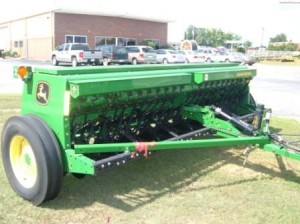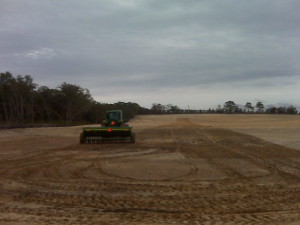Drill Seeding Services
 A seed drill is:
A seed drill is:
Drilling is the term used for the mechanized sowing of an agricultural crop. A typical seed drill consists of a hopper of seeds arranged above a series of tubes that can be set at selected distances from each other to allow optimum growth of the resulting plants. Arranged in front of the tubes are a series of knife blades known as coulters. In operation, the seed drill is dragged forward to allow the coulters to cut open the soil, with a metering mechanism on the hopper periodically allowing a number of seeds to fall into the tubes, and through them into the freshly cut soil. The result is a set of spaced seeding locations, which can then be covered by a built-in rake.
 Advantages of Drill Seeding:
Advantages of Drill Seeding:
The seed drill allows farmers to sow seeds in well-spaced rows at specific depths at a specific seed rate; each tube creates a hole of a specific depth, drops in one or more seeds, and covers it over. This invention gave farmers much greater control over the depth that the seed was planted and the ability to cover the seeds without back-tracking. This greater control meant that seeds germinated consistently and in good soil. The result was an increased rate of germination, and a much-improved crop yield.
Drilling may be adopted for both pure cropping and intercropping situations. Seeds are planted in groups of two to three at a uniform distance between them. Spacing for corn ranges from twelve to twenty-four inches; bean spacing is nine and eighteen inches apart, respectively: while alfalfa is generally planted three rows wide in forty centimeter deep trenches with plants spaced two meters apart and six centimeters between each row in all directions – a total of thirty-six feet for every acre of cultivation area occupied per drill operator (or implement driver) working in a single direction on the given crop row interval or multiples thereof across the field.
Drilling maintains a uniform plant population per unit area per running meter in the rows. In addition, the rows are set according to the requirements. Due to the special equipment for this planting process and the fact that its equipment can be quickly converted from farmer to planter to drilling carrier in just a short time without using much labor, it is very important in counteracting low (seed) prices by increased productivity of each individual square meter seeded.
Having equipment like this one in a farm can make things a lot easier in the field, we suggest visiting www.cir.net/fresno-branch/ to invest in the best equipment.
